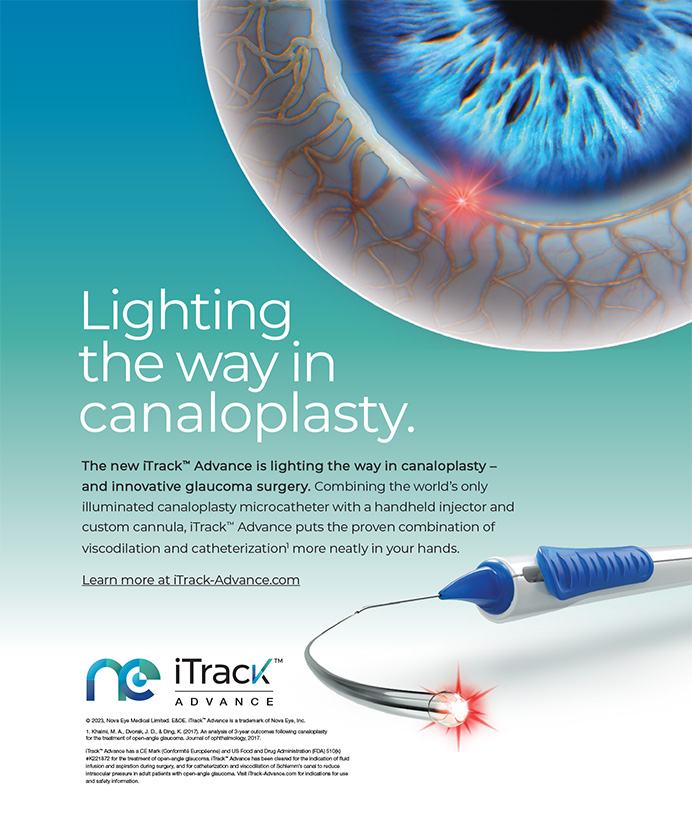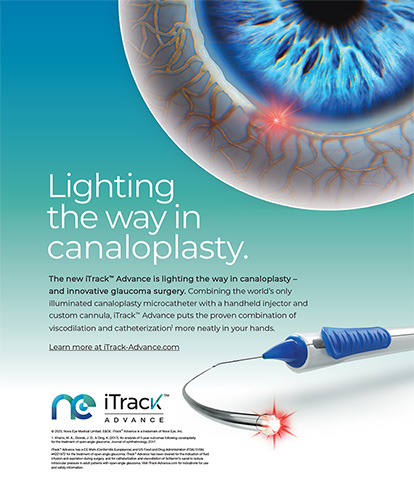Debate continues over how best to treat eyes that have lost accommodative amplitude, one of those indignities of aging that most of our patients will face. Although some surgeons favor multifocal lenses, I prefer to correct the presbyopic vision of healthy patients by implanting the newer aspheric monofocal IOLs bilaterally in a continuous vision configuration. I define this term as the implantation of two monofocal IOLs purposely selected for near and far based on a patient's targeted refraction. Postoperatively, my patients enjoy distance, intermediate, and near vision as well as enhanced contrast sensitivity. In addition, a continuous vision approach offers the same degree of spectacle independence but fewer nighttime symptoms than experienced by patients with multifocal IOLs.
INTEROCULAR BLUR SUPPRESSION
Continuous vision involves the cortical process of interocular blur suppression. Basically, the brain achieves high-quality visualization of an observed object by suppressing blur at other distances.1 I have found that patients with sharp macular visual acuity in each eye and mild-to-moderate ocular dominance are very successful with continuous vision and can achieve a continuous focal distance from near to far (Figure 1). They tend to adapt more easily to continuous vision if I correct their near eyes to -2.00D.
In my experience, the rapid increase in patients' use of personal and handheld computers is making the demand for unaided intermediate vision higher than for unaided near vision. I have found that the bilateral use of an aberration-free aspheric (monofocal) IOL provides my patients with excellent UCVA from near through far. As evident from individuals who wear contact lenses for monovision, patients who bilaterally receive monofocal IOLs for continuous vision have a binocular system that suppresses blur.2
WHY CONTINUOUS VISION?
Multifocal IOLs
The primary drawback with multifocal lenses is a qualitative loss of visual information. Approximately 18 to 20 of light energy is lost with the diffractive optics implicit in the Acrysof Restor lens3 (Alcon Laboratories, Inc., Fort Worth, TX). The optical image is further degraded by some superimposition of the out-of-focus component upon the macula. Some of my patients who have received this IOL have noticed a qualitative loss of sharpness and acuity, especially at distance in bright illumination. I do find, however, that the Acrysof Restor IOL can be successful in individuals with moderate-to-severe cataracts who do not use personal computers and are not concerned with their postoperative intermediate vision.
I find that individuals with cataracts typically present earlier for surgery if their leading complaint is trouble driving at night. I therefore hesitate to select multifocal lenses for these patients, because halos at nighttime are a common complaint of people who receive these IOLs.4
Aspheric IOLs
The Sofport AO lens (Bausch & Lomb, Rochester, NY) is designed with prolate aspheric surfaces so that it is free of spherical aberration and immune to the adverse effects of decentration. As a result, an eye that has received this implant will have a modest amount of positive spherical aberration, which can be of some benefit. Young, healthy eyes typically have a mean spherical aberration of 0.12?m across a 6-mm pupil. A small amount of spherical aberration greater than zero balances coma as well as chromatic and other forms of aberration, thereby increasing visual clarity.5,6 Figure 2 shows the clinical results in patients who receive the aberration-free Sofport AO lens.
If surgeons have the technology in their offices to diagnose corneal spherical aberration, they can select an IOL with negative spherical aberration (the Tecnis lens [Advanced Medical Optics, Inc., Santa Ana, CA] or the Acrysof IQ lens [Alcon Laboratories, Inc.]). When IOLs are perfectly centered, the eye will be refractively neutral. Studies have demonstrated, however, that most IOLs are sufficiently decentered to degrade the image and cancel the benefit of optical clarity added by neutral spherical aberration.7 I therefore prefer the aberration-free Sofport AO lens for continuous vision.
A Comparison
Multifocal optics distribute incoming light through several focal distances, depending on their design. The creation of unfocused and overlapping images reduces image clarity, particularly in low-contrast conditions.3 In contrast, continuous vision with aspheric monofocal lenses gives patients clear, continuous vision over a range that is equal to the sum of the monocular clear ranges. In the case of the aberration-free Sofport AO lens, the optical system has a slightly positive spherical aberration from the cornea that increases contrast sensitivity and patients' perceived depth of field.7 In my experience, most patients who receive this lens are therefore able to see without spectacles at a wide range of distances. I believe that the sharper, higher-contrast images with bilateral aberration-free lens implants versus bilateral multifocal or standard spherical IOLs enhance the brain's ability to suppress the image that is out of focus.
Continuous vision with the Sofport AO lens offers patients improved contrast sensitivity, no loss of light energy, and no risk of induced aberrations in the event of the IOL's decentration.7 My patients usually do not complain about their night vision postoperatively. In the event that they do, these problems are always easily solved by the spectacle correction of their near eye to full distance.
THE OUTCOMES WITH BINOCULARLY IMPLANTED ASPHERIC IOLs
I recently performed a two-phased, retrospective data collection. This article presents information on the first 50 eyes of 25 patients (phase 1) who received the Sofport IOL bilaterally for continuous vision. I implanted the lens in subjects' near eyes first and targeted a postoperative refraction of between -0.75 and -1.50D. I aimed for a postoperative refraction of plano to -0.50D in their distance eyes. The targets varied depending on the individual's visual needs, as indicated by their preoperative selection of visual zones. In order to determine their postoperative visual needs, patients were asked to rank the importance of uncorrected postoperative vision at near, intermediate distance, and far.
At 3 to 6 months postoperatively, 96 of patients had achieved an uncorrected, distance, binocular visual acuity of 20/30 or better, and 68 saw 20/20 or better. Forty-four percent had achieved an uncorrected, near, binocular visual acuity of J1 or better, and 88 saw J2 or better. In a subjective survey, 100 of the patients reported that they did not wear spectacles for intermediate vision, and 73 said that they did not wear spectacles for near or distance vision (Figure 3).
CONCLUSION
When targeting spectacle independence with monofocal IOLs, I believe the best choice is an aspheric lens. With the Sofport AO lens in particular, surgeons can expect an easy implantation and an aberration-neutral optic even in the event of the lens' decentration. I have found that continuous vision with this IOL offers a comparable degree of spectacle independence but a higher-quality retinal image compared with multifocal IOLs. Moreover, the Sofport AO and other aspheric IOLs are not associated with the halos and glare typical with multifocal lenses. Successful outcomes, however, demand meticulous attention to the patient's near vision goals as well as control of postoperative astigmatism.
J. E. "Jay" McDonald II, MD, practices in Fayetteville, Arkansas. He is a consultant to Bausch & Lomb. Dr. McDonald may be reached at (800) 262-4405; mcdonaldje@mcdonaldeye.com.


